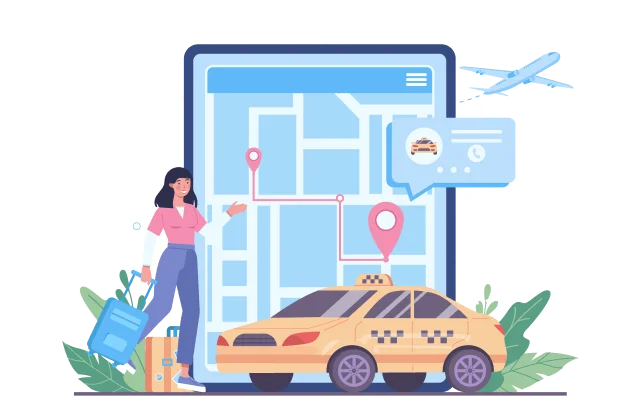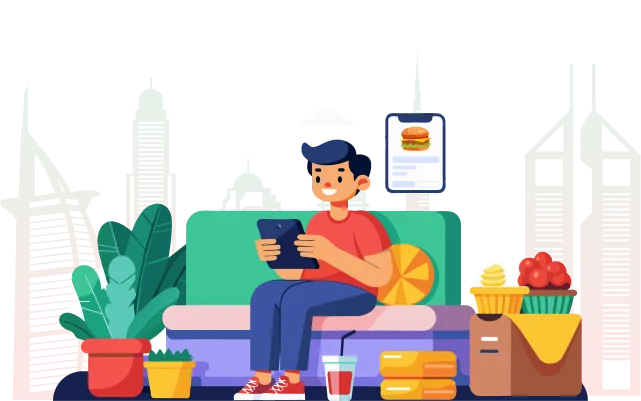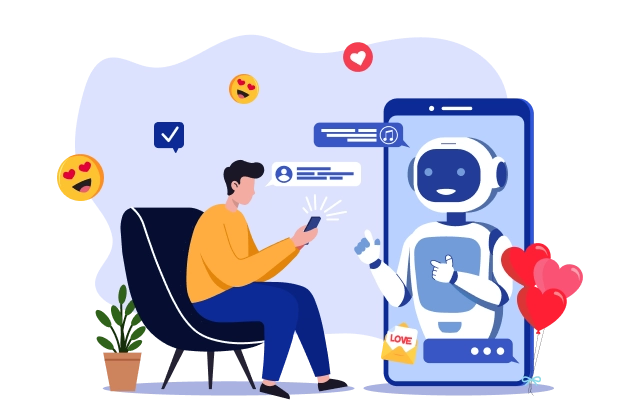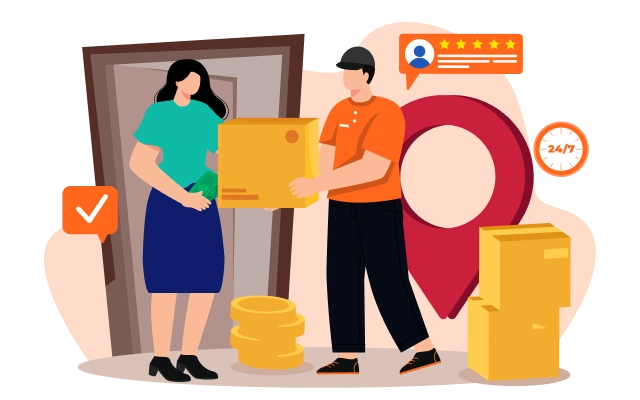Have you ever considered a scenario where calling a taxi seemed as easy as a single click on your smartphone? In the era of instant service drivers, Uber became the leader, changing the way we hail rides and modernizing urban transportation as we used to know it.
Uber’s range value is more than 91 million monthly active users worldwide, and its presence in over 90 cities on the global stage has disrupted the on-demand taxi booking system. Here in this article we will be discussing the various aspects of Uber’s game-changing business model with all the details and also we will have a look at various revenue sources of it.
Founded in 2009, Uber has gained the reputation of becoming the revolutionary service that strives to fit the needs of the modern-day customers that are constantly evolving. Uber did not only only close the gap between supply and demand of transport services but it did so in an unprecedented way; employing technologies, business plans and strategies that eventually created options that satisfied millions in all corners of the world.
In short, the on-demand taxi booking business is growing, and if you want to develop an app like Uber to revamp your conventional business, let’s uncover Uber’s profitable business and revenue model with all the related information.
What is Uber?
Uber is an MNC (multinational company) that hailed the transportation industry, unlike other taxicabs, through an on-demand taxi booking platform. It allows passengers to book a cab online and offers door-to-door transportation services without hassle.
Shocking Facts About Uber
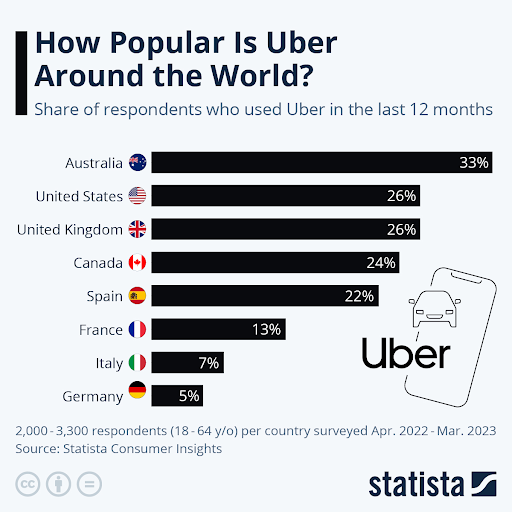
Source:
Statista- Launched in 2009 by Garrett Camp and Travis Kalanick, Uber soon became the world leader of affordable rideshare services in over 80 countries on six continents.
- Uber’s headquarters is located in San Francisco, California.
- The company now operates in an astonishing 900 metropolitan areas spanning 69 countries around the globe; besides taxi transportation, it offers a plethora of services.
- Beyond Uber’s Well-known ride-hailing service, Uber currently has several other offerings, including food delivery (Uber Eats), freight transportation (Uber Freight), and micro-mobility solutions (Uber Jump bikes and scooters).
- The company’s achievement is revealed by its tremendous audience, with more than 91 million monthly active users worldwide by 2020.
- From day one, Uber has changed the commute process, offering a straightforward, dependable, and convenient mode that does not differ from the iconic taxi and bus services.
Uber has become an industry leader in shaping urban mobility and redrawing the global transportation landscape through its visionary founders, inventive technologies, and unwavering dedication to perfection.
Unleash the On-Demand Potential
Harness the power of on-demand apps in your ride-sharing business.
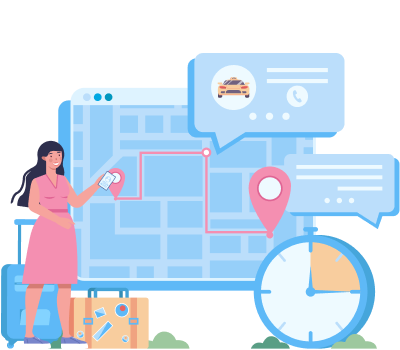
How Does Uber Work?
As told earlier, Uber has given birth to the on-demand economy and this is perhaps the reason why more and more people today are inclined towards user-friendly solutions. Let’s checkout how Uber works and make it easy for riders to access the services.
- On activation, it is simple to sign up as a user by giving personal details, i.e., name, email address, and credit card details.
- After the app is installed, users can hail a ride by putting in their pickup and drop-off locations through the interface.
- The algorithm of Uber picks up the request for the ride by assigning the closest available driver who meets some criteria like distance, traffic conditions, and driver ratings.
- The users will be given the important information related to the assigned driver like their names, photos, car details and their expected arrival time.
- The moment the ride request is confirmed, the user can see the driver’s whereabouts through the app in real time, so that he/she can keep track of the driver’s location and estimated arrival time.
- When the driver reaches the pick-up point, riders will be notified of that, and they can then continue the ride.
- During the trip the passengers can choose to communicate with the driver through the app for any particular instructions or updates which are needed.
- When the destination is reached, the fare is automatically charged considering divorce, time and any other extras including the surge pricing and tolls.
- When it comes to payments, they are done smoothly and conveniently via the app through various options like credit and debit cards, digital wallets, or cash where preferred and available in a particular region.
- At the ride-end, users can rate their ride and give some feedback that will contribute to driver ratings and overall quality of service.
In summary, Uber’s working flow revolves around the seamless integration of technology, convenience, and accessibility, providing users with a hassle-free transportation experience at their fingertips.
Let’s Decode Uber Business Model
Uber employs a dynamic business model based on the interaction between multiple stakeholders; each performs a vital role in the company’s success.
At its core, Uber’s business model revolves around three primary stakeholders: users, drivers, and admin. Through effectively synchronizing these interactions, Uber has overhauled urban transportation and become the new standard for people’s way from point A to point B.
Value Proposition
- The driver’s value proposition draws on the fact that the service is hassle-free, trusted, and affordable to the riders while at the same time allowing the drivers some freedom in their work schedules.
- Passengers experience easy access to rides on demand just with the touch of a button without a card, with features like real-time tracking, fairness in traffic rates, and payment efficiency.
- Regarding drivers, Uber provides an opportunity for independent income generation while giving them the freedom to determine their working hours and shifts without needing to stay at any chosen place.
Customer Segments
- Uber’s customer segment also comprises a mixture of urban commuters, travelers, and those who prefer to get certain transportation options at the convenience of their fingertips.
- Whether people ride Uber to avoid traffic jams, passengers, or to start a social life from tourists exploring new cities, the brand services a wide range of needs.
- Moreover, Uber offers a business-to-business (B2B) segment aimed at corporate clients and organizations, enabling them to manage employee transportation, events, and logistics.
Key Activities
- The main activities of Uber are related with the uninterrupted running of its platform, incorporating a broad range of functions and services of different nature.
- This category includes the training of the drivers, customer acquisition, user retention, maintenance and upgrading of the platform, customer support and regulatory issues. Furthermore, Uber spends significant funds on technology and innovation to improve its services, particularly in self-driving technology, map software and mobility resources.
Uber’s business model is a testament to the power of technology and innovation in transforming traditional industries. By prioritizing user experience, fostering partnerships, and leveraging data-driven insights, Uber continues to disrupt the transportation landscape and shape the future of urban mobility.
How Does Uber Make Money?
The fact that Uber’s boil down of the transportation industry is well demonstrated not only through its unique business model but also through its disordered income sources.
Let us review how Uber brings in revenue from the platform to fund its operations and fuel its growth.
Ride Fees
UBER’s main income source is fees charged to ride passengers on their trips. The price is set according to several parameters such as mileage, time, and capacity, with peak hours being the peak and busy hours attracting extra fees.
Commission Fees
Uber also charges a fee called ‘per ride commissions’ from drivers. Normally, the fare is based on a percentage of the total fare or the fixed price per ride.
Surge Pricing
Uber implements surge pricing on increased demand, raising fares to encourage more drivers to hit the road. The surge in pricing revenue is part of Uber’s overall income.
Uber Eats
As well as its drive-hailing services, Uber makes money from the food delivery platform UberEats. Restaurants give Uber a commission for every order delivered through the platform, thus giving the company another way to make money.
Through them and other revenue-generating plans, Uber has stepped into the big league of on-demand transportation and delivery business which makes it one of the most valuable companies on the planet and shapes the future of city transport of the future.
Invest in Uber Clone App to Become a Dominant Force in the Transportation Industry
As Uber’s revolutionary concept fully captures the thoughts of business people worldwide, there is no better time than now to seize this opportunity and show what you are made of in the transport sector. Uber’s triumph has opened the door to many young entrepreneurs who follow its path to launch new innovative products based on the by-now-proven uber business model and by tapping into the increasingly strong demand for their convenient and prompt transport services.
With the right implementation strategy and well-outlined plan, you can be the boss of that industry, building the future of city mobility and defining how people move from point to point.
If you wish to start this inspiring way and create a new app like Uber, welcome aboard. We are well-known for building problem-solving applications that fit your customers’ exact needs and desires, whether that may consist of a ride-hailing platform, food delivery, or any other solution.
With our knowledge and commitment, we can accompany you from brainstorming to launching to be sure that your Uber clone app outperforms all others in the competitive market and exceeds your dreams for years. Are you ready to pioneer a transportation revolution? Let’s talk and convert your business dreams into a success.


